|
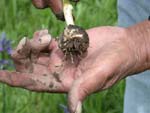 | | Camas Bulb |
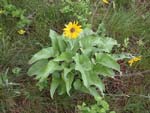 | | Balsamroot |
|
|
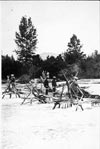 | | Dipnet Fishing from a Platform, ca. 1930s. |
With the arrival of spring the winter villages located along the shores of Lake Coeur d'Alene and the banks of the St. Joe, Coeur d'Alene, and Spokane Rivers are deserted for the root gathering areas. Family groups traveled to the prairie country to the east and south, where over sixteen species of roots were traditionally relied upon. Among the most important were the bitterroot (Lewisia rediviva Pursh), camas (Camassia quamash Pursh) and cous (Lomatium cous). Using a pitse’ (digging stick) it would be the women of the families who would use their knowledge and skills to gather, prepare and store this food source. Together with the berries gathered in the fall, these plant foods contributed to well over a third of the traditional Schitsu’umsh diet.
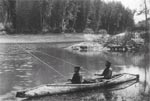 | | Fishing from a Birch-bark Canoe, ca. 1908 |
With spawning runs of the spring and into the fall, the families would continue their travel to the fishing areas. Using three-pronged spears, hemp-twine dip nets, and sapling and pole weirs, the men fished for several varieties of fish. Among the most important were the cutthroat trout (Salmo clarki) and mountain white fish (Prosopium williamsonii). With no anadromous fish allowed to enter Lake Coeur d'Alene (see Coyote and the Falls), to obtain the much desired chinook (Oncorhynchus tshawyscha), sockeye salmon (Oncorhynchus nerka), and steelhead trout (Salmo gaidener), families traveled to Spokane Falls, Kettle Falls and even as far away as Celilo Falls to fish and trade. Fish made up a third of the traditional diet. In exchange for salmon, the Schitsu’umsh traded dried venison and deer hides. These annual trips were also an important time to renew ties of friendship, to compete in stick games, to dance and feast, and to possibly seek a spouse in marriage.
|
|
Swe'itn - Tingling Springs - Listen as Felix Aripa, Tribal Elder, tells of one of the water holes on the way into the mountians, and of the importance of the Mountians. (recorded and edited by John Hartman as part of the Coeur d'Alene Tribal GIS Names-Place Project) |
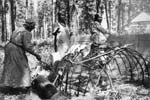 | | Smoking Salmon at Kettle Falls, ca. 1939 |
It would also be during the summer that individuals, both young men and women, would go to the adjacent mountains to pray, fast from food and water, and seek a guardian Animal Spirit. (See Songs: From the Animal People.) A Sweat House ritual would be conducted in preparation for this vision quest, as well as prior to hunting or traveling to a distant land. (See Songs: of the Sweat House.) If his or her prayers are heard, an Animal Spirit, such as an Elk, Wolf, or Hawk, might come and bestow a suumesh song, or spiritual power. With this great gift, assistance in hunting, gathering, fishing, and even healing the sick might be obtained. Both men and women could become healers of the sick. Acquiring a suumesh song was thus a critical part of becoming an adult.
© Coeur d'Alene Tribe 2002
< previous |
next >
|
|
|












